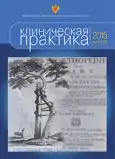ARTHROSCOPY-ASSISTED ANATOMICAL STABILIZATION OF CHRONIC ACROMIO-CLAVICULAR SEPARATION
- Authors: Agzamov DS1, Mukhanov VV1, Sovetnikov NN1, Akhpashev AA1, Tkalin AN1, Karpashevich AA1
-
Affiliations:
- Федеральный научно-клинический центр спеуиализированных видов медицинской помощи и медицинских технологий ФМБА России
- Issue: Vol 6, No 1 (2015)
- Pages: 67-72
- Section: Articles
- URL: https://journals.rcsi.science/clinpractice/article/view/8325
- DOI: https://doi.org/10.17816/clinpract6167-72
- ID: 8325
Cite item
Full Text
Abstract
Full Text
##article.viewOnOriginalSite##About the authors
D S Agzamov
Федеральный научно-клинический центр спеуиализированных видов медицинской помощи и медицинских технологий ФМБА Россиизаведующий отделением травматологии и ортопедии ФНКЦ ФМБА России, д.м.н., профессор.
V V Mukhanov
Федеральный научно-клинический центр спеуиализированных видов медицинской помощи и медицинских технологий ФМБА России
Email: victormukhanov@mail.ru
врач травматолог-ортопед отделения травматологии и ортопедии ФНКЦ ФМБА России
N N Sovetnikov
Федеральный научно-клинический центр спеуиализированных видов медицинской помощи и медицинских технологий ФМБА России
Email: sovetnikovnn@mail.ru
врач травматолог-ортопед отделения травматологии и ортопедии ФНКЦ ФМБА России
A A Akhpashev
Федеральный научно-клинический центр спеуиализированных видов медицинской помощи и медицинских технологий ФМБА России
Email: akhpashev@yandex.ru
врач травматолог-ортопед отделения травматологии и ортопедии ФНКЦ ФМБА России, доцент кафедры травматологии РУДН, к.м.н.
A N Tkalin
Федеральный научно-клинический центр спеуиализированных видов медицинской помощи и медицинских технологий ФМБА Россииврач травматолог-ортопед отделения травматологии и ортопедии ФНКЦ ФМБА России
A A Karpashevich
Федеральный научно-клинический центр спеуиализированных видов медицинской помощи и медицинских технологий ФМБА Россииврач травматолог-ортопед отделения травматологии и ортопедии ФНКЦ ФМБА России
References
- Fraser-Moodie JA, Shortt NL, Robinson CM. Injuries to the acromioclavicular joint. J Bone Joint Surg Br. 2008; 90: 697-707.
- Rockwood CJ, Williams GDY. Disorders of the acromioclavicular joint. / In: Rockwood C, et al. The shoulder. 4nd ed. Philadelphia: WB Saunders; 2008
- Mazzocca AD, Arciero RA, Bicos J. Evaluation and treatment of acromioclavicular joint injuries. Am J Sports Med. 2007 Feb; 35(2): 316-29.
- Debski RE, Parsons IM 3rd, Fenwick J, et al. Ligament mechanics during three degree-of-freedom motion at the acromioclavicular joint. Ann Biomed Eng 2000; 28: 612-18.
- Ludewig PM, Behrens SA, Meyer SM, Spoden SM, Wilson LA. Threedimensional clavicular motion during arm elevation: reliability and descriptive data. J Orthop Sports Phys Ther. 2004; 34: 140-9.
- Klimkiewicz J, Williams G, Sher J, Karduna A, Des Jardins J, Iannotti JP. The acromioclavicular capsule as a restraint to posterior translation of the clavicle: a biomechanical analysis. J Shoulder Elbow Surg. 1999; 8: 119-24.
- Fukuda K, Craig E, An KN, Cofield RH, Chao EY. Biomechanical study of the ligamentous system of the acromioclavicular joint. J Bone Joint Surg Am. 1986; 68: 434-40.
- Lee SJ, Keefer EP, McHugh MP, Kremenic IJ, Orishimo KF, Ben-Avi S. Cyclical loading of coracoclavicular ligament reconstructions: a comparative biomechanical study. Am J Sports Med. 2008; 36(10): 1990-7.
- Cox JS. The fate of the acromioclavicular joint in athletic injuries. Am J Sports Med 1981; 9: 50-53.
- Dias JJ, Steingold RF, Richardson RA, et al. The conservative treatment of acromioclavicular dislocation. Review after five years. J Bone Joint Surg Br 1987; 69: 719-22.
- Lemos MJ. The evaluation and treatment of the injured acromioclavicular joint in athletes. Am J Sports Med. 1998; 26: 137-44.
- Larsen E, Bjerg-Nielsen A, Christensen P. Conservative or surgical treatment of acromiocla vicular dislocation. A prospective, controlled, randomized study. J Bone Joint Surg Am 1986; 68: 552-5.
- Deshmukh AV, Wilson DR, Zilberfarb JL, et al. Stability of acromioclavicular joint reconstruction: biomechanical testing of various surgical techniques in a cadaveric model. Am J Sports Med 2004; 32: 1492-8.
- Mazet R Jr. Migration of Kirschner wire from shoulder region into lung: report of two cases. J Bone Joint Surg 1943, 25: 477-83.
- Sim E, Schwarz N, Hocker K, et al. Repair of complete acromioclavicular separations using the acromioclavicular-hook plate. Clin Orthop 1995, 314: 134-42.
- Tauber M, Gordon K, Koller H, Fox M, Resch H. Semitendinosus tendon graft versus a modified Weaver-Dunn procedure for acromioclavicular joint reconstruction in chronic cases: a prospective comparative study. Am J Sports Med. 2009; 37(1) :181-90.
- Costic RS, Labriola JE, Rodosky MW, Debski RE. Biomechanical rationale for development of anatomical reconstructions of coracoclavicular ligaments after complete acromioclavicular joint dislocations. Am J Sports Med. 2004; 32: 1929-36.
- Rutter PW, Petersen SA. Anatomical coracoclavicular ligament reconstruction: a biomechanical comparison of reconstructive techniques of the acromioclavicular joint. Am J Sports Med. 2005; 33: 1723-8.
- Wolf EM, Pennington WT. Arthroscopic reconstruction for acromioclavicular joint dislocation. Arthroscopy. 2001 May; 17(5): 558-63.
- Gian MS, Lars WALZ, Philip BS, et al. Arthroscopic anatomical reconstruction of the acromioclavicular joint. Acta Orthop Belg 2008; 74: 397-400.
- The Cowboy’s Companion: A Trail Guide for the Arthroscopic Shoulder Surgeon / Burkhart S, Lo IKY, Brady PC, Denard PJ. LWW, 2012.
Supplementary files






